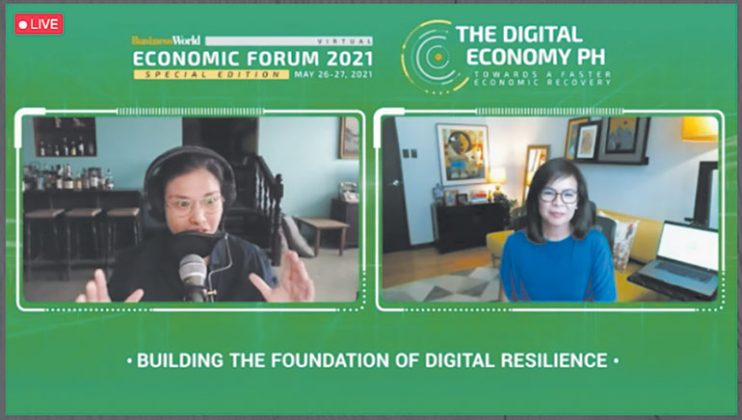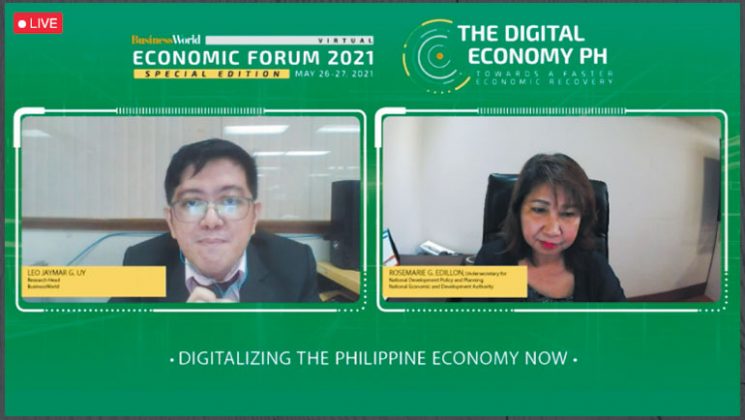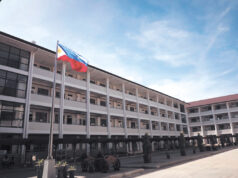Facing and responding to a digital reality

By Bjorn Biel M. Beltran, Special Features Writer
Digitalization has become the life-saving buoy against the tide of the COVID-19 pandemic for the business world, keeping companies operational even as quarantine measures restricting face-to-face interactions have shut down most offices everywhere.
In fact, more companies are realizing the potential of the digital world towards enhancing their capabilities. In a recent report, the International Data Corporation said that it expects global direct digital transformation investment to grow at a compound annual growth rate of 15.5% from 2020 to 2023, to approach $6.8 trillion as companies build on existing strategies and investments, becoming digital-at-scale future enterprises.
What does this entail for a country like the Philippines?
The recently-concluded BusinessWorld Virtual Economic Forum 2021 Special Edition gathered three experts to illustrate what a digitally-capable future looks like for the country, and the steps needed before it can achieve it. In the first of such Fireside Chats, Karrie C. Ilagan, managing director Cisco Philippines, discussed the importance of digital resilience in a post-COVID-19 world.
“This pandemic has changed the world forever. The digital transformation that is happening now has dramatically altered how we work and live. It has changed the role of many businesses because the needs of their customers are continuing to evolve rapidly. There has never been more urgency for organizations to deliver digital-first services,” Ms. Ilagan said.
She added, “Digital resilience is about being ready for change and disruption. It’s about being ready to adapt and find opportunities in rapidly shifting environments.”
Ms. Ilagan pointed out the importance of building a solid digital infrastructure for a company to find and take advantage of opportunities provided by constantly evolving technologies, whether it is by augmenting operations via digital networks or utilizing cloud services.
To this, such an infrastructure must have security and privacy as its core.
“Cybersecurity is at the core of the success of every digital effort,” she pointed out. “I don’t think anybody can successfully be digitally transformed unless they take to heart cybersecurity.”
Because the scope of the digital world has expanded to encompass even sectors like education, Ms. Ilagan said that there is an urgent need now to simplify systems, placing a strong focus on creating better cybersecurity. She called on organizations, industry leaders, and government officials to educate the public about data security and privacy to create a more digitally resilient society.
Cisco’s UGNAYAN 2030 program is one such effort aimed at launching key digitization initiatives to help the economy, create jobs, and promote innovation and next-generation skills development across the private and public sectors.
To give the government’s perspective on the country’s digitalization journey, Rosemarie G. Edillon, undersecretary for policy and planning of the National Economic and Development Authority, discussed the long process of digitalizing the Philippine economy.
Ms. Edillon was quick to point out that the demand for and the usage of digitalization is not as widespread as it appears in Metro Manila.
“If you look at all across the country, that is not the case. That may be true here in NCR (National Capital Region), but we found that there is very low usage in digital payments and e-commerce outside the capital. Even those putting their products online, they do not allow digital payments and instead prefer cash-on-delivery,” Ms. Edillon said.
“The first thing we need to do is increase this demand, and at the same time improve our digital infrastructure,” she said.
She pointed out that around 64% of barangays in the country do not have telecommunication towers to access the Internet, while 88% of barangays lack free Wi-Fi zones for their residents and 70% of barangays do not have fiber optic cables installed. The huge disparity between these areas and more urbanized areas are creating an increasingly wider digital divide that separates those who can take advantage of digital transformation and those who cannot.
In this effort, both the public and private sectors have roles to play.
“We’ve been consistent that the main driver of the economy is the private sector and the role of government is to steer the economic triggers towards the direction where we want it to go,” she said.
The government, for its part, needs to lay down the policy framework and code of conduct for the players participating in the digital economy. This includes promoting technological adoption among Filipinos, educating them on cybersecurity and digital literacy, and bridging the digital divide by streamlining the process of constructing cell towers.
Ensuring consumer protection during online transactions, making digital transformation inclusive, and trying to bring down the cost of connectivity, she said, are policies and programs that the government can enact to take the country further towards a digital economy.
Mamerto E. Tangonan, deputy governor for payments and currency management sector at the Bangko Sentral ng Pilipinas, discussed this further as he talked about the central bank’s Digital Payments Transformation Roadmap 2020-2023.
Mr. Tangonan said that the volume of digital payments in the Philippines has increased from a 25 million monthly average with a value of $5.92 billion in 2013 to 782 million in the first half of 2020, amounting to $29 billion.
The 2019 BSP Financial Inclusion survey found that 69% of adults own a mobile phone and about 53% use the Internet. Meanwhile, only 12% of mobile phone owners and only 9% of Internet users use these technologies for financial transactions. This is a huge opportunity for financial institutions to reach unbanked Filipinos.
Mr. Tangonan said that the roadmap is aimed at creating financial inclusion through the development of an accessible and secure digital payments framework by building the necessary digital finance infrastructure and digital governance and standards. Future payments digitalization initiatives will include PESONet multiple batch settlement, bills payments, request to pay, and direct debit.
“Digital technology can massively promote financial inclusion, but there is a need to deliberately and purposefully harness this potential by ensuring that anyone can readily open and use an account through digital channels for various financial transactions,” he said.
Mr. Tangonan added, “This roadmap contributes to [central bank] Governor Diokno’s strategic direction of bringing the BSP closer to the Filipino people.”






